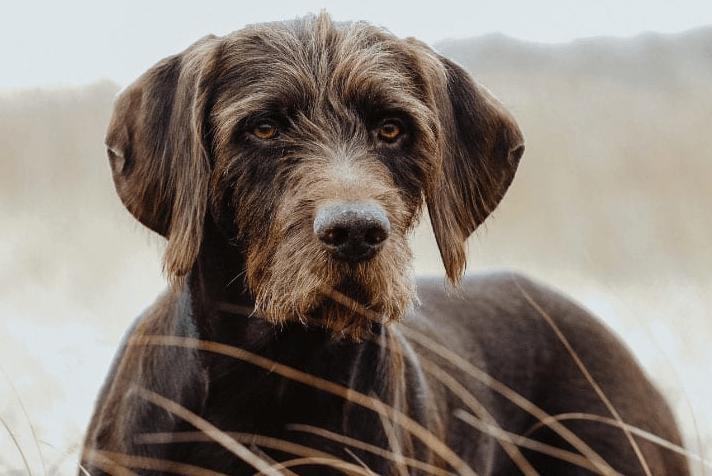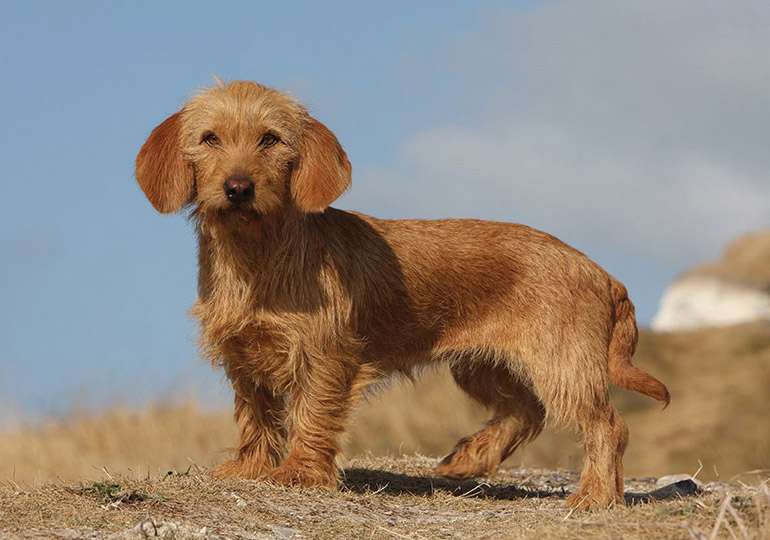
Description
The Pudelpointer resembles a Pointer in appearance and is a medium-sized, strong-boned gun dog. Pudelpointers have medium-length, close-lying, rough coats with a rich undercoat. They have cute beards and a hairpiece on top of their foreheads. Typically, they have brown, dead leaf (a paler shade of brown), or black coats. There are little white marks on some dogs. This breed has huge, dark amber eyes and a flat, relatively broad cranium. The flat, medium-sized ears of puddelpointers are densely haired. Their slender tails, carried like a sabre, are straight and reach the hock.
Origin/History
In the late 1800s, Germany was the birthplace of the Pudelpointer. Gun dogs tailored to their style of hunting were being developed at the time by German sportsmen. Hegewald, a well-known author and authority on hunting dogs, persuaded hunters to breed Poodles with English Pointers. In order to accomplish this, he set out to cross the English Pointer’s keen nose, pointing reflexes, and enthusiasm for hunting with the Poodle’s love of the water, trainability, retrieving abilities, and protective coat.
Breeders started the breeding programme with much more Pointers than Poodles. Once they had the desired appearance and personality, they stopped relying on Pointers and started mating Pudelpointers with other Pudelpointers. The first Pudelpointer club was established by breeders in 1897 after the breed register was established in 1892.
In 1956, Sigbot Winterhelt and H.D. Hume brought the breed to North America. The majority of Pudelpointers raised today are in Germany or the US. The breed was acknowledged by the United Kennel Club in 2006, and since 2016, the American Kennel Club has kept a record of it in their Foundation Stock Service.
Temperament
Pudelpointers are inherently hunting dogs. They make a great choice for waterfowl hunters since they have good retrieving instincts and a love of water. These collected, well-behaved puppies often get along well with other canines. Additionally, they have a clownish mentality and a cheerful, laid-back disposition. They are therefore just as entertaining to be around at home as they are in the field.

Care
Nutrition
Pudelpointers do best with a high-quality diet designed for their size and life stage (e.g., puppy, adult, senior). Dog obesity is becoming a bigger health issue. Keep an eye on their food intake and measure their portions with a regular measuring cup to prevent overeating to assist yours maintain a healthy weight. Also, remember to factor in treats. As a general rule, they ought to comprise no more than 10% of a dog’s daily caloric intake.
Grooming
Pudelpointers’ coats require weekly brushing to eliminate stray hair. They will stay cleaner if they take occasional showers, especially after a day of hunting in the woods or field. Also, don’t overlook the nails. Every dog should have regular nail trimmings as part of their grooming regimen. Longer-than-normal nails can hurt and possibly make it difficult to run or walk.
Finally, your dog’s general health depends on maintaining appropriate oral hygiene. Plan professional cleanings accordingly, and create a dental chewing routine for your pet that includes frequent tooth brushing at home.
Exercise
Pudelpointers require a significant amount of daily exercise, much like other hunting dogs. With long walks, treks, and backyard chase games, you can keep your dog busy. These dogs also enjoy sports that make use of their natural talents, such swimming and retrieving. Other excellent opportunities include agility, rally, and competitive obedience.
Training
Pudelpointers are typically simple to teach, bright dogs that are eager to please. Using their preferred toys or sweets as rewards will keep them interested and receptive throughout training sessions. In order to help your puppy grow into a well-adjusted adult dog, be careful to socialize them as early as possible.
Table





